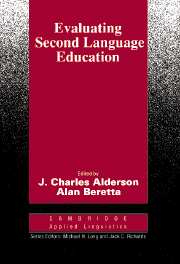Book contents
- Frontmatter
- Contents
- List of contributors
- Series editors' preface
- Acknowledgements
- Introduction
- I EVALUATION OF LANGUAGE EDUCATION: AN OVERVIEW
- II CASE STUDIES OF CURRENT PRACTICE
- Chapter 1 Insiders, outsiders and participatory evaluation
- Chapter 2 Evaluating a program inside and out
- Chapter 3 The ‘independent’ evaluation of bilingual primary education: a narrative account
- Chapter 4 Issues in evaluating input-based language teaching programs
- Chapter 5 Program-defining evaluation in a decade of eclecticism
- Chapter 6 Evaluation of classroom interaction
- Chapter 7 Moving the goalposts: project evaluation in practice
- Chapter 8 What can he learned from the Bangalore Evaluation
- III GUIDELINES FOR THE EVALUATION OF LANGUAGE EDUCATION
- Appendices
- Author Index
Chapter 4 - Issues in evaluating input-based language teaching programs
from II - CASE STUDIES OF CURRENT PRACTICE
Published online by Cambridge University Press: 05 October 2012
- Frontmatter
- Contents
- List of contributors
- Series editors' preface
- Acknowledgements
- Introduction
- I EVALUATION OF LANGUAGE EDUCATION: AN OVERVIEW
- II CASE STUDIES OF CURRENT PRACTICE
- Chapter 1 Insiders, outsiders and participatory evaluation
- Chapter 2 Evaluating a program inside and out
- Chapter 3 The ‘independent’ evaluation of bilingual primary education: a narrative account
- Chapter 4 Issues in evaluating input-based language teaching programs
- Chapter 5 Program-defining evaluation in a decade of eclecticism
- Chapter 6 Evaluation of classroom interaction
- Chapter 7 Moving the goalposts: project evaluation in practice
- Chapter 8 What can he learned from the Bangalore Evaluation
- III GUIDELINES FOR THE EVALUATION OF LANGUAGE EDUCATION
- Appendices
- Author Index
Summary
Introduction
During the academic year 1985–6, an eight-month experimental course in first-year German was offered at the University of Utah. The experiment was designed to test the feasibility of using a radical implementation of Krashen's theory of second language acquisition. Steven Sternfeld directed the program, and Paul Kramer and Louise Lybbert Nygaard taught the experimental courses. These individuals, along with several graduate students in the Department of Linguistics, developed and administered the tests and questionnaires used to evaluate the courses. I assisted in the planning phase of the evaluation and worked with the two German instructors (Kramer and Nygaard) in developing and refining the instructional methodology. I was also involved in designing the attitude questionnaires. Kramer is responsible for the analysis of the German performance measures, which were scored by him and several other raters. Thus, this chapter should be considered a report on the program evaluation efforts of a fairly large team of individuals.
When we started thinking about how to evaluate the experimental German course, we had to consider the options, organize them, and select those in which we were interested. We would have found it useful to have on hand a document describing how someone else had dealt with the issues we were facing, and we might have saved considerable time and energy in developing a plan that worked for us. The general purpose of this chapter is to provide other researchers with this kind of a head start.
- Type
- Chapter
- Information
- Evaluating Second Language Education , pp. 141 - 166Publisher: Cambridge University PressPrint publication year: 1992
- 2
- Cited by



